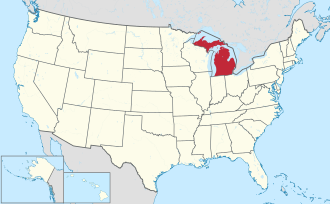Dickinson County | |
|---|---|
 | |
 Location within the U.S. state of Michigan | |
 Michigan's location within the U.S. | |
| Coordinates: 46°00′N87°52′W / 46°N 87.87°W | |
| Country | |
| State | |
| Founded | 1891 [1] [2] |
| Named after | Donald M. Dickinson |
| Seat | Iron Mountain |
| Largest city | Iron Mountain |
| Area | |
• Total | 777 sq mi (2,010 km2) |
| • Land | 761 sq mi (1,970 km2) |
| • Water | 16 sq mi (41 km2) 2.0% |
| Population | |
• Estimate (2024) | 25,995 |
| Time zone | UTC−6 (Central) |
| • Summer (DST) | UTC−5 (CDT) |
| Congressional district | 1st |
| Website | www |
Dickinson County is a county in the Upper Peninsula of the U.S. state of Michigan. As of the 2020 census, the population was 25,947. [3] The county seat is Iron Mountain. [4] Dickinson is Michigan's newest county, formed in 1891 from parts of Marquette, Menominee, and Iron counties. [2] It was named for Donald M. Dickinson, who served as U.S. Postmaster General under President Grover Cleveland. [1] [2]
Contents
- Geography
- Major highways
- Airport
- Adjacent counties
- Communities
- Cities
- Charter township
- Civil townships
- Census-designated place
- Other unincorporated communities
- Demographics
- Government
- Elected officials
- See also
- References
- External links
Dickinson County is part of the Iron Mountain, MI–WI micropolitan statistical area.


